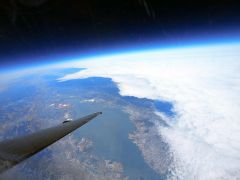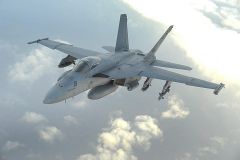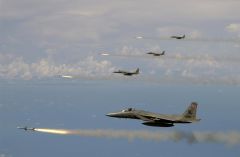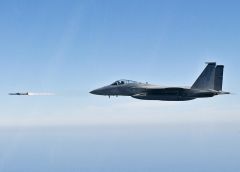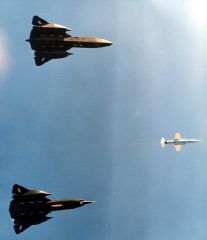-
Numero contenuti
5669 -
Iscritto il
-
Ultima visita
-
Giorni Vinti
44
Tutti i contenuti di -{-Legolas-}-
-

Questo è caduto in Pakistan ....
-{-Legolas-}- ha risposto a TT-1 Pinto nella discussione Drones ed Aerei Spia
Anche su Danger Room ne parlano. -
Forse ha dedotto che fosse supersonico, notando la freccia alare accentuata. Anche senza avere importanti nozioni di aereonautica, di solito è difficile sbagliarsi su questo.
-

Il futuro del programma spaziale USA
-{-Legolas-}- ha risposto a -{-Legolas-}- nella discussione Spazio
"Soyuz has launched more than 1,700 times over its long career, according to Ascend's SpaceTrak, making it the most frequently-used booster system. Soyuz has suffered a total of 88 failures since its first launch in 1957, with only one occurring within the past 10 years." E' curioso che, il primo lancio fallito di una Soyuz da dieci anni a questa parte, sia accaduto subito dopo il pensionamento degli Shuttle. Sembra un monito. -

Abbattere i razzi kassan in volo.
-{-Legolas-}- ha risposto a fabri nella discussione Armi superficie-superficie
Iron Dome in funzione. Sabato scorso i terroristi hanno lanciato una salva di Kassam sul sud d'Israele, dove due batterie di Iron Dome hanno dato prova di se. -
Ben detto, ed aggiungo un'altra galleria di foro dal Daily Mail Online
-
La chiglia vuota partita dall'Ucraina anni fa, ora è una portaerei salpata per le prove di navigazione. Duemila uomini d'equipaggio, la possibilità di imbarcare 50 aereomobili, motori diesel o a turbina. Vediamo i numeri riportati schematicamente: Fonte: The Wall Street Journal
-

Problemi Installazione Flamming Cliffs (1)
-{-Legolas-}- ha risposto a attore11 nella discussione Simulatori di volo
Hai provato a leggere il forum della digitalcombatsimulations? -

Osama Bin Laden Ucciso in Pakistan
-{-Legolas-}- ha risposto a °Delta nella discussione Discussioni a tema
Un articolo completo del New York Times sulla cattura di OBL. GETTING BIN LADEN -

VIDEO Sezione Bombardieri & Attacco al suolo
-{-Legolas-}- ha risposto a admin nella discussione Bombardieri & Attacco al suolo
-

"Boeing B-17 Flying Fortress"
-{-Legolas-}- ha risposto a Blue Sky nella discussione Velivoli Storici
"The flak was just terrible. The flak was ripping trough the airplane, i did think we never make it back.... This airplane, brought us back." -

Osama Bin Laden Ucciso in Pakistan
-{-Legolas-}- ha risposto a °Delta nella discussione Discussioni a tema
Ma sai Roby,anche solo per il mascheramento del rumore pare abbiano lavorato molto bene,infatti leggevo che non ci sono state sentinelle in allarme ad aspettarli,anche perchè non si sono rese conto che gli elicotteri fossero così vicini e diretti nella direzione del compound di OBL. Quindi molto bene direi. -
Local media reports said the Su-27s were trying to catch a U-2 spy plane conducting a surveillance mission out of Osan Air Base, South Korea. The reports said the U-2 diverted to Kadena Air Base, Okinawa, to avoid the Chinese fighters. But surveillance aircraft specialist Chris Pocock was skeptical. There are only three U-2s based in East Asia, all at Osan, to watch North Korea, Pocock said. “They may also fly southwards along the China coast as far as Taiwan, but not on a routine basis,” he said. The aircraft might have been a U.S. Navy EP-3 Aries or U.S. Air Force RC-135, which operate at lower altitudes and have been harassed by Chinese fighters in the past. In 2000, two Chinese J-8 fighters intercepted a U.S. Air Force RC-135 in international airspace above the East China Sea. A year later, a J-8 fighter collided with a U.S. Navy EP-3 Aries near Hainan Island in the South China Sea. Despite Chinese complaints, the U.S. surveillance aircraft flies regular missions along China’s coastline. They stay in international airspace because straying into Chinese territory would make them easy targets for S-300PMU-1/2 and Hongqi-10 surface-to-air missiles. Read more: http://defensetech.org/#ixzz1TUh8Ktj5 Defense.org Fonte: Defence Tech
-

Afghanistan - Topic ufficiale
-{-Legolas-}- ha risposto a Thunderalex nella discussione Discussioni a tema
Alcuni decessi sono brevemente descritti qui, coprendo il periodo che va dal 2004 al 2010 Il 31 dicembre 2010 è morto il caporal maggiore thienese Matteo Miotto, 24 anni. Il 9 ottobre quattro militari italiani sono rimasti uccisi nell'esplosione di un ordigno al passaggio di un convoglio nel distretto del Gulistan, a circa 200 chilometri a est di Farah. Il 17 settembre muore l'incursore Alessandro Romani, raggiunto da colpi di arma da fuoco in un attentato nella provincia di Farah. Il 28 luglio perdono la vita a una ventina chilometri da Herat, a seguito dell'esplosione di un ordigno rudimentale (ied), Mauro Gigli e Pierdavide De Cillis. Il 25 luglio muore, forse suicida, un militare italiano. Si sarebbe sparato un colpo di arma da fuoco all'interno del suo ufficio, a Kabul. Sull'episodio stanno indagando i carabinieri della polizia militare. Il 23 giugno muore a Shindand, nell'ovest dell'Afghanistan, il caporal maggiore scelto Francesco Saverio Positano. Il militare ha perso l'equilibrio ed è caduto da un mezzo blindato, riportando un forte trauma cranico. Apparteneva al 32° reggimento Genio, della Brigata Alpina Taurinense. Il 17 maggio, un veicolo blindato salta in aria per l'esplosione di un ordigno nella provincia di Herat. Muoiono il sergente Massimiliano Ramadù, 33 anni, e il caporal maggiore Luigi Pascazio, 25 anni. Le vittime appartenevano al 32° reggimento Genio della brigata Taurinense. Il 26 febbraio viene ucciso Pietro Antonio Colazzo, un funzionario della Aise, l'Agenzia di informazione e sicurezza esterna, nel corso di un attentato suicida compiuto dai talebani a Kabul contro due guesthouse. Il 15 ottobre 2009 un militare del quarto reggimento alpini paracadutisti muore in un incidente stradale avvenuto sulla strada che unisce Herat a Shindad. Il 17 settembre 2009 sei militari muoiono in un attentato suicida a Kabul, rivendicato dai talebani. Le vittime, del 186° reggimento paracadutisti Folgore di stanza a Kabul: sono Antonio Fortunato, Matteo Mureddu, Davide Ricchiuto, Massimiliano Randino, Roberto Valente e Gian Domenico Pistonami. Il 14 luglio 2009 muore, in un attentato a 50 chilometri da Farah, il caporalmaggiore Alessandro Di Lisio, 25 anni. oaracadutista dell'ottavo genio guastatori della Folgore; faceva parte di un team specializzato nella bonifica delle strade. Il 15 gennaio 2009 muore Arnaldo Forcucci, maresciallo dell'Aeronautica, per arresto cardiocircolatorio. Il 21 settembre 2008 muore per un malore a Herat il caporalmaggiore Alessandro Caroppo, 23 anni, dell'ottavo reggimento bersaglieri di Caserta. Il 13 febbraio 2008 muore in un attacco il maresciallo Giovanni Pezzulo, 44 anni, del Cimic Group South di Motta di Livenza. L'attentato avviene a una sessantina di chilometri da Kabul, nella valle di Uzeebin, mentre i militari italiani sono impegnati in attività di distribuzione di viveri e vestiario alla popolazione della zona. Rimane ferito il maresciallo Enrico Mercuri. Il 24 novembre 2007 muore in un attentato suicida nei pressi di Kabul il maresciallo capo Daniele Paladini, 35 anni. Altri tre militari rimangono feriti. Il 4 ottobre 2007 muore al Policlinico militare del Celio l'agente del Sismi Lorenzo D'Auria. Il militare era stato gravemente ferito il 24 settembre 2007 durante un'operazione delle forze speciali britanniche per cercare di liberarlo. Due giorni prima, D'Auria era stato sequestrato assieme a un altro sottufficiale del servizio di sicurezza militare e a un collaboratore afgano. Il 26 settembre 2006 perdono la vita i caporalmaggiori Giorgio Langella, 31 anni, e Vincenzo Cardella, in seguito all'esplosione di un ordigno lasciato lungo una strada nei pressi di Kabul. I due militari appartenevano alla ventuneesima compagnia del secondo reggimento alpini di Cuneo. Il 20 settembre 2006 muore in un incidente stradale, a sud di Kabul, il caporalmaggiore Giuseppe Orlando, 28 anni. Faceva parte della ventiduesima compagnia del secondo reggimento alpini di Cuneo. Il 2 luglio 2006 il tenente colonnello Carlo Liguori, 41 anni è stroncato da un attacco cardiaco ad Herat. Il 5 maggio 2006, in seguito all'esplosione di un ordigno lasciato lungo una strada nei pressi di Kabul, muoiono il tenente veronese Manuel Fiorito, 27 anni, e il maresciallo Luca Polsinelli, 29 anni, entrambi del secondo reggimento alpini. I due soldati si trovavano a bordo di due veicoli blindati «Puma», a sud-est della capitale afgana, quando sono stati investiti dall'esplosione. L'11 ottobre 2005 muore il caporalmaggiore capo Michele Sanfilippo, 34 anni. Sanfilippo, effettivo al Quarto Reggimento Genio Guastatori di Palermo, viene ferito con un colpo alla testa, partito accidentalmente, nella camerata del battaglione Genio a Kabul. Muore poco dopo il ricovero in ospedale. Il 3 febbraio 2005 l'ufficiale di Marina Bruno Vianini perde la vita nello schianto di un aereo civile sul quale viaggiava, tra Herat e Kabul. Il capitano di fregata aveva 42 anni. Il 3 ottobre 2004, il caporal maggiore Giovanni Bruno, 23 anni, del terzo reggimento alpini, è vittima di un incidente stradale mentre si trova a bordo di un mezzo dell'esercito nel territorio di Sorobi, a 70 chilometri da Kabul. Nell'incidente rimangono feriti altri quattro militari. Fonte: L'arena.it -
-

in ricordo per i 97 ragazzi bardaramente assasinati in norvegia
-{-Legolas-}- ha risposto a cama81 nella discussione Discussioni a tema
Chiudo la discussione, e lascio tutti i posto al loro posto, cosicchè tutti possano vedere di tanto in tanto quanto stavate scendendo in basso. Era un pò che non mi capitava di vedere un parapiglia così. Forza signori, tornate a parlare di aerei. Prima di chiudere, a nome di tutti i volenterosi rinnovo il senso di sconforto di fronte ad atti efferati come questa strage, e compassione per i familiari delle vittime, condannando senza sconti Breivik. -
Throughout history, borders have been created to divide places and separate people. While these can take the form of physical barriers, many—such as the median line dividing the Taiwan Strait into territory controlled by Taipei and Beijing—never become anything more than lines drawn on maps. But this does not diminish the importance of these borders or make them any less contentious or impermeable. Chen Shih-min, an associate professor of political science at National Taiwan University in Taipei, believes Beijing’s call to scrap the median line is a sharp reminder for Taipei that despite improving cross-strait ties, the two sides still maintain confrontional relations. “Abandoning the median line in the Taiwan Strait is only possible if Beijing renounces the use of force against the island,” Chen said July 7. “From a military perspective, demilitarizing air space along the line would only favor [mainland China] as Taipei has no plans for direct military action against Beijing.” The issue of dispensing with the median line reared its head July 2 after Wang Yi, director of mainland’s Taiwan Affairs Office under the State Council, called on Taipei to consider opening the median line to ease cross-strait flight congestion on the northern and southern routes. “To meet increasing demand, cross-strait flights need to reach around 700 to 800 per week,” Wang claimed. “Doing away with the line is the best way to achieve this.” The median line was drawn in 1955 by General Benjamin O. Davis Jr., commander of the 13th Air Force, then based in Taipei. Following a series of air battles over the Taiwan Strait in 1958, both Taiwan and mainland China seemingly reached a tacit agreement over the line’s existence. Incursions into each other’s airspace were scaled back and the possibility of renewed conflict minimized. Despite the mutual consensus, Beijing never recognized the median line’s existence since it maintains Taiwan is an inalienable part of its territory. As far as Beijing is concerned, the only reason to maintain such a non-binding agreement with Taipei is because both sides share a special and complex relationship shaped over nearly 60 years. As the second-highest ranking mainland leader to call for dispensing with the median line, Wang’s comment set the cat among the pigeons in Taiwan’s Presidential Office. President Ma Ying-jeou wasted no time in rejecting Wang’s call out of hand. “We have clearly stated our position to Beijing. While we have no intention of being difficult, the issue is one of national security.” For Chen, the median line issue can be traced back to the ROC’s relocation to Taiwan in 1949 and growing antagonism between Taipei and Beijing. He maintains that preserving air and naval superiority in the Taiwan Strait has always been an essential part of the island’s defense policy. “In order to defend Taiwan against an attack from the People’s Liberation Army, maintaining a high state of military readiness in the Taiwan Strait is a fundamental part of the country’s security policy, irrespective of which party is in power,” Chen said. Chen explained that the median line issue has received little attention for nearly a decade, mainly because of former President Lee Teng-hui’s July 1999 comment that Taiwan and mainland China have a “special state-to-state” relationship. “Lee’s remark led to Beijing suspending bilateral talks,” he said, adding that former President Chen Shui-bian’s hard-line “anti-China” policy did not improve this situation any. Chen said it is also worth noting the role of the media in the median line issue. “Some pro-unification outlets tend to oversimplify the concept of the median line as being a creature of conflicting demands and policies during the Cold War,” he said. “They intentionally fashion an image or argument that favors their particular political agenda.” Chen proposes that Beijing used this out-of-date argument to bring pressure to bear on some within the KMT, denouncing them as having a Cold War approach to cross-strait relations. “The [mainland Chinese] leadership took advantage of this issue to communicate with those ‘refuseniks’ in the Ma administration and encouraged them to adapt to post-Cold War thinking,” he said, adding that from Beijing’s perspective, a more “pragmatic” attitude should be introduced into discussions over this issue. In addition to his remarks concerning the median line, Wang also reiterated Chinese Communist Party General-Secretary Hu Jintao’s call last December for Taipei to establish a mechanism to build mutual trust between the military of both sides. Ma adroitly sidestepped Wang’s comment, instead stating that what is more urgent and pressing at the moment, is for the two sides to solve the issues that matter most to the public. “Exchanges between Taipei and Beijing should focus on economic issues first and then political affairs,” he said. Chen states that Ma’s emphasis on economic issues can be explained within the context of domestic politics and the dynamics of Taipei, Washington and Beijing’s strategic relationship. From the perspective of domestic politics, opening the median line is a key component of national security and considered “high politics," Chen said. “But to date, progress in cross-strait negotiations since Ma took office last May has been primarily confined to economic issues, or low politics.” “Why Ma repeatedly reiterates his position of economics first and then politics is because if he compromises on the median line, opposition charges that he is sacrificing Taiwan’s sovereignty to appease Beijing may jeopardize his administration’s ruling legitimacy,” Chen said. “If Ma wants to consolidate his power domestically, the island’s mainstream public opinion, which favors maintaining the status quo, cannot be overlooked.” As for Washington, the academic said given its long-standing policy of “strategic ambiguity” toward the Taiwan Strait, maintaining the equilibrium between Taipei and Beijing best serves U.S. interests in the Asia-Pacific region. “Under this policy, the United States does not want Taiwan to be independent or move too quickly toward [mainland China]. From this position, opening the median line might touch a U.S. nerve as such an issue is a feature of cross-strait security,” Chen said. According to Chen, despite Taipei’s rejection of Beijing’s recent overtures, the current state of cross-strait interactions would likely remain unchanged. “It appears Beijing is focused on working to help the KMT secure and consolidate its legitimacy as a ruling power on the island.” “For Beijing, Ma’s victory in Taiwan’s presidential election last March offered up an unprecedented opportunity for advancing bilateral political relations,” Chen said. “This is because the then president-elect made it clear that seeking de jure independence for the island would never be an option for his administration.” With Beijing perceiving Ma’s good will as a “once-in-a-lifetime opportunity” to move both sides even closer to their long-held goal of peaceful unification, Chen cautions that the median line issue will remain a thorny one for some time to come. “Although the median line is invisible, its impact on cross-strait relations is very real and of great significance. Improving economic ties will not see it erased overnight.”(JSM) Fonte:http://taiwantoday.tw/ct.asp?xItem=54923&ctNode=413
-
A metà giugno, un U-2 è stato costretto ad abortire una missione, quando due Su-27 hanno varcato la linea mediana nello stretto di Taiwan, che costituisce un confine ufficioso tra la Cina continentale e l'isola. Era dal 1999 che caccia cinesi non varcavano la soglia. Fonte: Taiwan Today
-
-
-
Il sito della NASA, che mostra le ricadute tecnologiche del programma Shuttle sulla vita quotidiana. http://www.sti.nasa.gov/tto/ Molto interessante.
-
Il passato e il futuro. C'è qualcosa che non mi torna.
-
Veramente impressionante. Trent'anni, e quanti sogni, quante ambizioni quante speranze nella gente che ha partecipato al programma che nell'arco di un trentennio ha plasmato l'era del volo orbitale. Non ci sarà più uno Shuttle sul quale volare, l'onore di prendere parte di un idea che ha consolidato le strade del cielo intorno alla nostra Terra, portando a compimento missioni come l'Hubble, la ISS per esempio. Non si sono fermate le navette, davanti a tante difficoltà, a costo di grandi sacrifici. Da oggi in poi ci saranno le navette commerciali, e razzi vettore e capsule usa e getta a portare gli esperimenti e gli astronauti lassù, nell'orbita di casa. Ora le speranze vanno al volo oltre, verso una nuova frontiera, che qualcuno raccolga la sfida per lasciare il giardino di casa ed andare sempre più in la... to boldly play, where no man, has gone before.
-
Caspita. Ci vuole ingegno e tempo per trovare un fattore come questo e non lasciare niente al caso.


